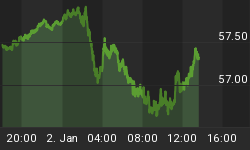The good news is:
• The NYSE AD line hit a new cycle high last week.
• The number of new lows remains insignificant.
• Both the NYSE and NASDAQ new high indicators are heading upward.
This implies new cycle highs in the blue chip indices in the next 2-6 weeks.
With the high percentage of fixed income related issues trading on the NYSE and stocks and bonds running out of synch for several years, there is good reason to be suspicious of the current value of the NYSE new high indicator. That said, let's have a look at it:
The chart below shows the Dow Jones Industrial Average (DJIA) in red and a 10% trend (19 day EMA) of NYSE new highs (calculated on a 52 week trailing basis as reported by the exchange) (NH) in green. I have put dates on several of the peaks to help with the time perspective. The indicator does not adjust for the total number of issues traded so I have included the figures on the selected dates:
| Date | Value of NH | Issues Traded | NH as a % of issues traded |
| Nov 82 | 219 | 1940 | 11% |
| March 86 | 288 | 2040 | 14% |
| July 97 | 337 | 3440 | 10% |
| Jan 2004 | 445 | 3430 | 13% |
Notice the indicator peaks well in advance of a price peak.

Take a closer look at the marked periods:
The chart below shows the period before and after the 1982 peak. The indicator peaked at about the half way point of the price run.

The next chart shows the March 86 peak of the indicator followed by a peak in prices about a year and a half later.

The next chart shows the indicator peak in July of 1997 and the price peak two and a half years later in January 2000.

The last chart in this series shows where we are now.
The indicator peaked in late January suggesting there is a lot more room on the upside.

What about next week?
Nearly all of the charts are telling the same story as the one below. The indicator (blue) tries to force the activity of the index, in this case the Russell 2000 (red), into a 25 day cycle. The indicator is nearly, but not quite maxed out.

I pay a lot of attention to the direction of the NASDAQ new high indicator (10% trend of NASDAQ new highs) shown in the chart below. It has turned upward.

There is no evidence that the up move of the past 2 weeks is ending, but the recent (past 2 months) rhythm of the market suggests it does not have much time left. There are no notable seasonal factors at play next week.
I expect the major indices will be higher on Friday March 12 than they were on Friday March 5.
















